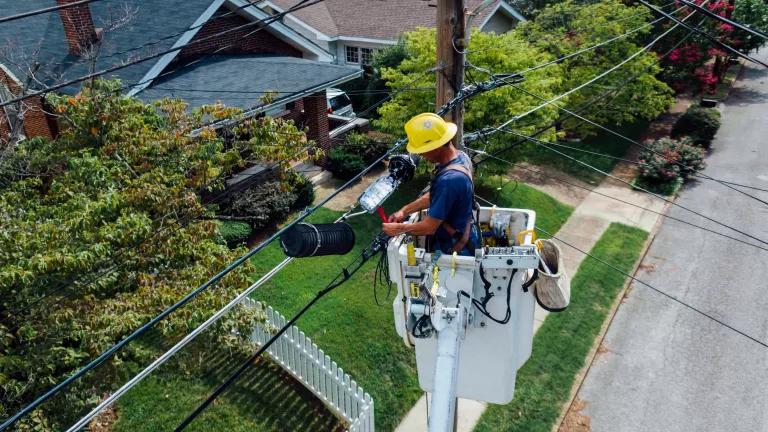Biden Plan Promises Better Buildings, for Climate and Equity
The incoming Biden-Harris administration faces four interlocking crises that must be tackled head-on.

UPDATE: On November 23, 2020, NRDC and 26 other groups urged the incoming Biden administration to prioritize key actions that federal agencies can take now under existing law to cut greenhouse gas emissions through building energy efficiency.
The incoming Biden-Harris administration faces four interlocking crises that must be tackled head on: the COVID-19 pandemic, economic recovery from it, persistent racial injustices, and the existential threat of climate change. Focusing on these crises is at the heart of the Biden-Harris Build Back Better transition plan.
A critical area is our homes and buildings, which are responsible for around 40 percent of all U.S. carbon emissions, and many low-income communities of color suffer from the impacts of substandard housing. The new administration knows that smarter energy use is the cheapest, fastest, strongest weapon against the climate crisis and can improve the lives of Americans coping with the pandemic, high energy bills, and poor housing conditions.
The Biden-Harris administration plan commits the United States to achieving a 100 percent clean energy economy, with net-zero emissions, no later than 2050. For our buildings, this means starting by meeting the new administration’s promise to upgrade the energy efficiency of at least 4 million buildings and weatherize at least 2 million low-income homes over the next four years. That will drive down the climate impact of buildings while saving households and businesses money and getting people back to work in the clean energy economy.
Furthermore, the plan aims to spur construction of 1.5 million sustainable, low-income homes. These actions must be built on a platform of accessible, affordable housing policies and environmental justice, which will ensure housing, high-quality jobs, and investments in communities historically left behind.
What does this look like in practice? Here are some specific policies that can help achieve these goals equitably.
Low-Income Weatherization
The federal Weatherization Assistance Program (WAP) should be significantly scaled up and expanded. It currently improves the efficiency of more than 35,000 homes annually but nearly 40 million homes are eligible. This means that while the Biden-Harris promise to weatherize 2 million homes in the next four years is a strong start (14 times greater than current practice!), it would still take over 80 years at that accelerated rate to meet the need. Reaching all eligible homes requires scaling up even more dramatically–and a corresponding budget increase.
Program funds also must be made available to improve housing conditions (such as repairing a roof so the home can be insulated), and to replace fossil fuel equipment like furnaces and water heaters with efficient electric options.
WAP lowers energy bills and reduces energy burden, cuts carbon emissions, increases occupants’ health and comfort, and improves the housing stock of low-income households–all of which align with new administration’s top priorities.
Existing Building Retrofits and Appliance Standards
The Biden-Harris promise to retrofit 4 million buildings in four years is big, but it may not be big enough given the scale of the climate crisis. We must think bigger and bolder, in a way that achieves the 2050 net zero carbon goals while prioritizing affordable housing, and ensuring better health, safety, and resiliency without contributing to displacement.
While there are existing legislative ideas on the table, they may not go far enough to achieve truly deep retrofits. Practically speaking, we must accelerate the use of direct incentives to homeowners, renters, and businesses through generous rebates and tax credits for high-efficiency equipment and whole-building retrofits that save more energy, while also developing additional mechanisms to promote decarbonization technologies, specifically in low-income communities.
We need to drive down the costs of electric heat pump technology for both water heating and space heating, as this technology will get our homes and businesses off fossil fuels entirely once all our electricity is generated from clean, renewable resources.
The national appliance and equipment standards program–historically one of the federal government’s strongest tools for saving energy–must be revived and strengthened, overturning years of neglect and nefarious action by the current Department of Energy. The Biden team has indicated they plan to prioritize this program through existing executive authority. Strong standards ensure that efficient products are available at any point of purchase, cutting utility bills and driving down the costs of products over time.
Low-Carbon New Construction
New buildings must be constructed to be efficient, low-carbon, and healthy from the start, eliminating the need for costly energy-saving retrofits later. Standards should be in place to achieve this goal in new buildings by 2025. Cities and states have the authority to adopt low-carbon, all-electric building codes, but there is the (incorrect) perception that this will be costly for builders or make code compliance more difficult.
As cities and states struggle with massive budget deficits due to the pandemic, the federal government should generously fund the adoption and implementation of better building codes. This will help maintain momentum in the cities and states that have the political will to act but lack the resources to do so.
Equitable Housing
Our nation is amid an affordable housing crisis. The new administration must extend and strengthen the national eviction moratorium expiring at the end of 2020, and put in place other emergency relief while encouraging Congress to pass the HEROES Act, which includes rental, energy, and water assistance.
The Biden team commits to building 1.5 million homes and public housing units to address the affordable housing crisis, increase energy efficiency, and reduce the racial wealth gap through more equitable housing development. In conjunction with other policies that address housing discrimination and affordable housing supply, this will help deliver more affordable, equitably distributed housing nationwide.
Conclusion
The Biden administration knows investing in America’s homes and buildings can benefit every family and business, and investments must be focused on the communities who need them most. Tackling the carbon emissions of our buildings–while ensuring equitable housing for all–is well within our reach.



